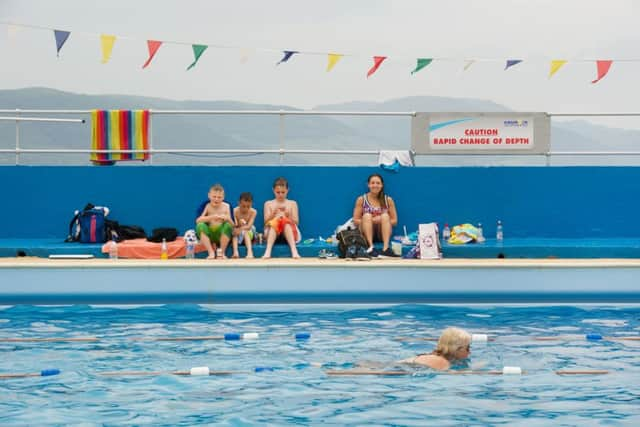Outdoor swimming remains a way of life for many Scots


But the Olympic-sized salt-water outdoor pool at Stonehaven has remained popular with holidaymakers since it opened in June 1934. The Art Deco complex receives around 30,000 visitors a year, a number which fluctuates according to the whims of Scottish summer weather.
When tentative plans were made to close the pool in the mid-1990s, a vigorous local campaign soon persuaded Aberdeenshire Council to think again.
Advertisement
Hide AdAdvertisement
Hide AdStonehaven remains one of only two fully maintained outdoor salt-water pools north of the border still welcoming swimmers. That number could rise to three if plans to refurbish the A-listed complex at Tarlair, some 60 miles to the north, come to fruition.


The other example can be found in the Inverclyde town of Gourock. First opened in 1909, the stylish pool – which offers balmy water temperatures of 29 degrees – underwent a substantial refurbishment in 2011.
But what makes swimming outdoors so appealing in a climate like Scotland’s? “Gourock Pool is in a class of its own when it comes to swimming and enjoying the great outdoors,” said Robert Moran, provost of Inverclyde.
“With spectacular views across the Firth of Clyde and a refurbished and unique Art Deco styling, the pool has attracted families from across Scotland for many years.
“Lidos are still a bit of a novelty for many, and Gourock pool remains popular because of the beautiful location and modern facilities on offer.


“We take great pride in being able to offer this fabulous facility and hope that generations young and old come to enjoy a memorable day out here in Gourock.”
Mention outdoor pools to those of a certain age from Edinburgh and the conversation will immediately turn to Portobello.
Advertisement
Hide AdAdvertisement
Hide AdThe suburb to the east of the city was once a holiday destination in its own right. To capitalise on this, a vast Art Deco outdoor pool was commissioned and opened in 1936. It boasted the first mechanised wave machine in Scotland, while the water was heated by the near-by Portobello power station.
Pictures from the 1950s and 1960s prove just how popular the complex was, with queues snaking down Westbank Street, and a one-in-one-out policy in place at peak times.


But numbers tailed off in the 1970s as Scots increasingly looked abroad for their holiday plans. The idea of swimming outdoors – when new, indoor alternatives were becoming increasingly common – went out of fashion.
The Portobello pool closed in 1979 and its demolition was approved in 1988 – a decision still regretted by many.
Yet when it comes to indoor swimming, the capital is still blessed with an extraordinary heritage.
Edinburgh Leisure, which manages sport and leisure venues on behalf of the local authority, runs five Victorian pools. The sixth of the capital’s historic pools remains a private club – Drumsheugh Baths.


Glasgow has its own Victorian treasures, with the private Western and Arlington baths clubs remaining popular.
Advertisement
Hide AdAdvertisement
Hide AdThe small North Woodside pool is the sole municipal complex still in operation.
Swimming pools can arouse surprising levels of civic pride, as the saga of Govanhill Baths proves.
The last remaining Edwardian bathhouse in Glasgow, it was closed in 2001 by the local authority – which claimed its upkeep could not be justified given a lack of customers.
Plans were unveiled last month to re-open Govanhill Baths as a community-run sports centre after eight years of fundraising by local campaigners. A community trust was established and eventually took control of the building in 2008.
Volunteers have since worked tirelessly to fund the building’s maintenance by using the empty main pool as a unique performance space.


It was the award of a Heritage Lottery grant last year that kick-started long-held plans to welcome back swimmers.
The building will now close in September to allow the former ladies pool – the second largest of the three – to be fully renovated.